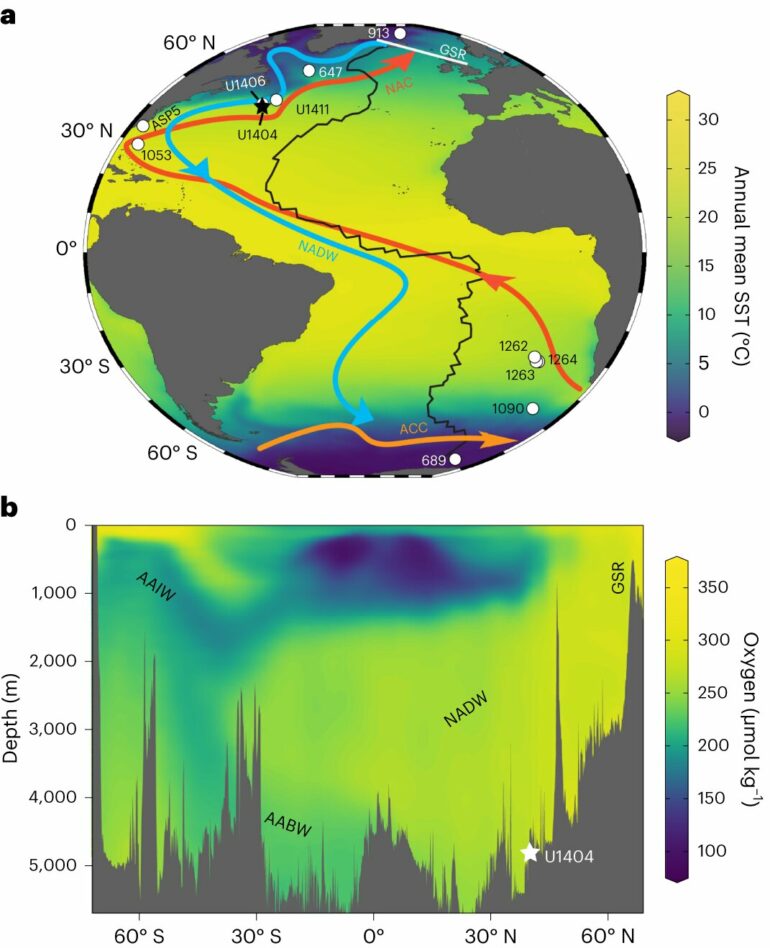The oxygen content of seawater has a profound impact on the cycling of bioessential elements and the habitability of Earth. But how and why the marine oxygen landscape (i.e., the spatial pattern of oxygen levels) evolved since the start of the Phanerozoic 538 million years ago is not well established.
To tackle this problem, researchers led by Prof. Wang Xiangli from the Institute of Geology and Geophysics of the Chinese Academy of Sciences (IGGCAS) and Prof. Li Chao from the Chengdu University of Technology, along with collaborators from the University of Cincinnati and the Nanjing Institute of Geology and Paleontology, have reconstructed a nearly continuous record of the spatial pattern of marine oxygen levels through the Phanerozoic based on a machine learning approach.
The study was published in Nature Geoscience on Oct. 26.
They found that over timescales of 10–100 million years, oxygen levels in deep continental shelf seawater were negatively correlated with the production rate of the oceanic crust—an indicator of the speed of plate movement.
Over shorter (i.e., million-year) timescales, the milestones of the reconstructed oxygen evolution process coincide temporally with major biological innovations (such as the colonization of plants on land around 400 million years ago and the revolution of marine zooplanktons around 250 million years ago) and supercontinent cycles (such as the amalgamation and breakup of Pangaea around 420 and 200 million years ago, respectively).
“Atmospheric oxygen levels are not always correlated with marine oxygen levels,” said Prof. Wang.
Before the advent of plants, the deep continental shelf was replete with reductants such as dissolved organic matter and ferrous iron. Therefore, despite the significant rise of atmospheric oxygen levels, the deep continental shelf largely remained devoid of oxygen, with only ephemeral oxygenation events.
After plants colonized continents, atmospheric oxygen was able to reach the deep continental shelf (primarily through thermohaline circulation), gradually leading to a “sandwich-like” marine oxygen structure in the continental shelf area, where an oxygen-deficient intermediate layer was sandwiched between oxygen-rich surface and deep layers. In this scenario, atmospheric and deep continental shelf ocean oxygen levels were positively correlated.
With the advent of marine zooplanktons about 250 million years ago, their hard shells and fecal pellets helped particulate organic matter sink faster from the upper ocean to the deep water, thus stripping away oxygen from the deep. As a result, despite atmospheric oxygen remaining high, deep continental shelf oxygen levels varied drastically due to ups and downs of the biological pump.
Marine anoxia (i.e., depletion of dissolved oxygen) has been frequently suspected as one of the causes of marine animal die-offs. This study, however, reveals that the extent of marine anoxia is not always associated with a high marine animal extinction rate.
The unexpected correlation occurs in time periods with low sea-level elevation (e.g., 300–170 million years ago), where the extinction rate is negatively correlated with the intensity of marine anoxia, suggesting that intensification of marine anoxia was not the major culprit in the higher marine animal extinction rate during this time interval.
Other factors, such as the loss of continental shelf habitat due to a large sea-level fall or fast temperature change, may have been linked to a high extinction rate in low sea-level times.
More information:
Xiangli Wang et al, Spatial pattern of marine oxygenation set by tectonic and ecological drivers over the Phanerozoic, Nature Geoscience (2023). DOI: 10.1038/s41561-023-01296-y
Provided by
Chinese Academy of Sciences
Citation:
Study shows marine oxygen landscape was shaped by plate movement and biological innovation (2023, November 1)



